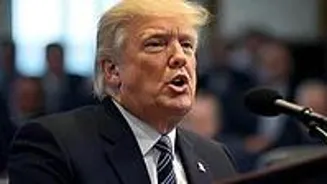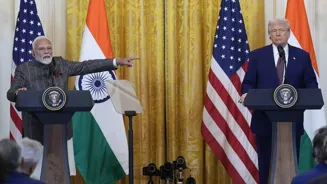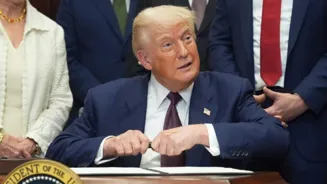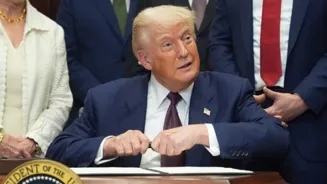Aug 6: US President Donald Trump's tariff decisions since he took office on January 20 have shocked financial markets and sent a wave of uncertainty through the global economy.
Here is a timeline of the major developments:
February 1: Trump imposes 25 per cent tariffs on Mexican and most Canadian imports and 10 per cent on goods from China, demanding they curb the flow of fentanyl and illegal immigrants into the US.
February 3:Trump agrees to a 30-day pause in his tariff threat on Mexico and Canada in return
February 10: Trump raises tariffs on steel and aluminum to a flat 25 per cent.
March 3: Trump says 25 per cent tariffs on goods from Mexico and Canada will take effect from March 4 and doubles fentanyl-related tariffs on all Chinese imports to 20 per cent.
March 6: Trump exempts goods from Canada and Mexico under a North American trade pact for a month.
March 26:Trump unveils a 25 per cent tariff on imported
April 2: Trump announces global tariffs with a baseline of 10 per cent across all imports and significantly higher duties on some countries.
April 9: Trump pauses for 90 days most of his country-specific tariffs that kicked in less than 24 hours earlier and caused an upheaval in financial markets. The 10 per cent blanket duty on almost all US imports stays in place.
Trump says he will raise the tariff on Chinese imports to 125 per cent from the 104 per cent level that took effect a day earlier,
May 9: Trump and British Prime Minister Keir Starmer announce a limited bilateral trade agreement that leaves in place 10 per cent tariffs on British exports and lowers duties on British car exports.
May 12: The US and China agree to temporarily slash tariffs. Under the 90-day truce, the US will cut the extra tariffs it imposed on Chinese imports to 30 per cent, while China's duties on US imports will be slashed to 10 per cent from 125 per cent.
May 23: Trump warns Apple it would face a 25 per cent tariff if phones it sold in the US were manufactured outside of the country.
May 29: A federal appeals court temporarily reinstates the most sweeping of Trump's tariffs, pausing an earlier lower court's ruling to consider the government's appeal.
June 3: Trump signs an executive proclamation activating a hike in the steel and aluminum tariffs to 50 per cent from 25 per cent.
July 3:Trump says the US will place a 20 per cent tariff on many Vietnamese
July 6: Trump says on Truth Social that countries aligning themselves with the "Anti-American policies" of Brics will be charged an additional 10 per cent tariff.
July 7: Trump says on Truth Social the additional higher duties announced previously will kick in on August 1. In letters sent to 14 countries including Japan, South Korea and Serbia, he says that will include tariffs between 25 per cent and 40 per cent.
July 10: Trump says the US will impose a 35 per cent tariff on imports from Canada in August and plans to impose blanket tariffs of 15 per cent or 20 per cent on most other trading partners.
July 15: Trump says the US will impose a 19 per cent tariff on goods from Indonesia under a new agreement.
July 22: Trump strikes a trade deal with Japan that includes lowering tariffs on auto imports to 15 per cent.
July 27:The US reaches a trade agreement with the European Union, imposing a 15 per cent import tariff
July 28: Trump says most trading partners that do not negotiate separate trade deals would soon face tariffs of 15 per cent to 20 per cent.
July 30: Trump says the U.S. will impose a 25 per cent tariff on goods imported from India, and places a 50 per cent tariff on most Brazilian goods, with softer quotas for sectors such as aircraft, energy and orange juice.
The US reaches a deal with South Korea, reducing the planned levies to 15 per cent.
He says a 50 per cent tariff on copper pipes
July 31: Trump signs an executive order imposing import tariffs ranging from 10 per cent to 41 per cent on 69 trading partners ahead of the trade deal deadline.
He issues a separate order raising duties on Canadian goods subject to fentanyl-related tariffs to 35 per cent, from 25 per cent previously.
He grants Mexico a 90-day reprieve from higher tariffs of 30 per cent on many goods to allow time to negotiate a broader trade pact.
August 6:Trump imposes
(This is an agency copy. Except for the headline, the copy has not been edited by Firstpost staff.)















